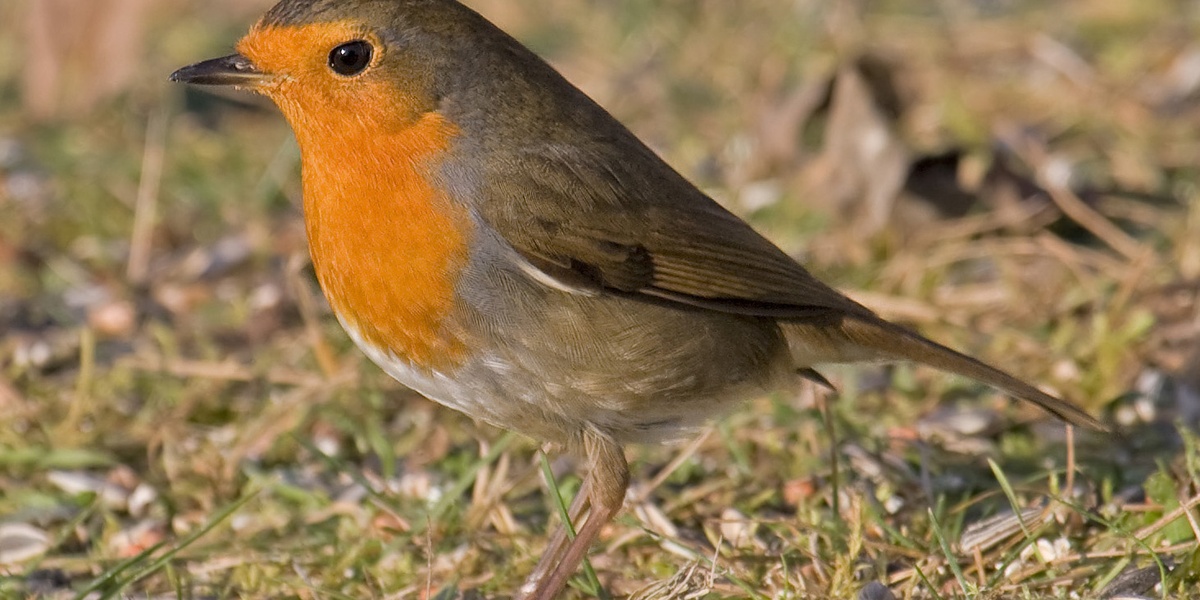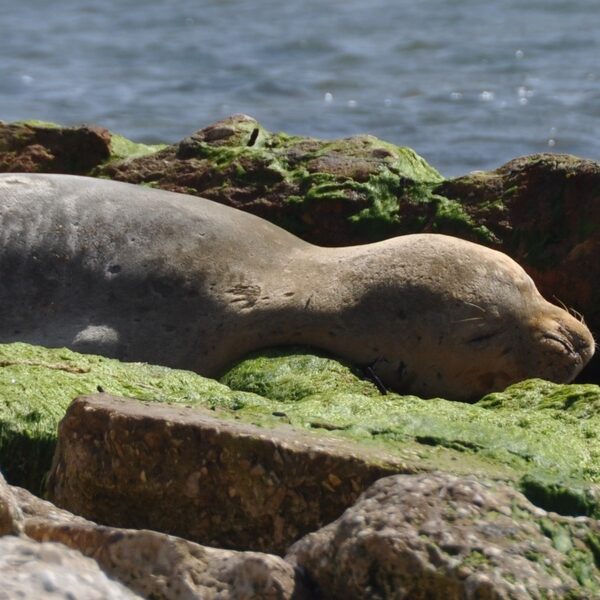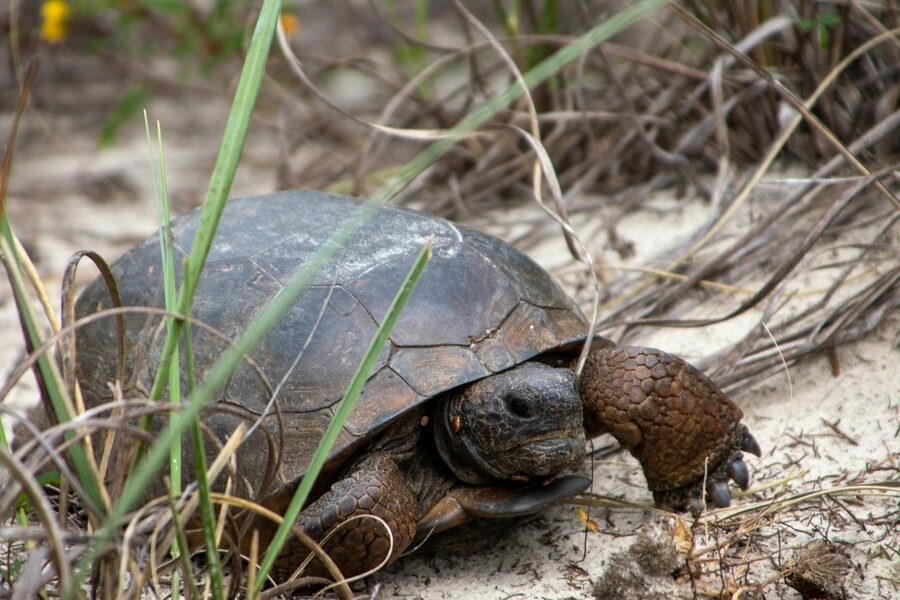The United Kingdom’s landscapes—from saltmarshes and estuaries to hedgerows and ancient woodlands—support a rich variety of birdlife and a long tradition of local and visiting observers. Seasonal movements and habitat differences across regions mean the checklist reflects residents, migrants and occasional visitors found here.
There are 100 Birds of the United Kingdom, ranging from Avocet to Woodcock. For each species you’ll find below concise entries organized into columns: Scientific name, Status, Main locations, so you can quickly check taxonomy, conservation notes and where to look.
How was this list compiled?
The list draws on accepted national checklists and recent taxonomic updates, supplemented by conservation bodies’ records and regional reports; status labels indicate breeding, migratory or rare/vagrant categories, and names follow standard scientific usage to keep the entries consistent and searchable.
Where are the best places to see species like the Avocet or Woodcock?
Look to habitat first: Avocet favors saline lagoons, estuaries and managed wetlands, especially during breeding and passage; Woodcock is most often found in damp woodland, scrub and hedgerows, visible at dusk or during winter flushes—check local reserve sightings and seasonal reports listed below for current hotspots.
Birds of the United Kingdom
| Common name | Scientific name | Status | Main locations |
|---|---|---|---|
| Mute Swan | Cygnus olor | Breeding | Widespread UK; lowland lakes, rivers, parks |
| Whooper Swan | Cygnus cygnus | Wintering | Scotland, N. Ireland, N. England; wetlands, flooded fields |
| Bewick’s Swan | Cygnus columbianus | Wintering | England (esp. East Anglia); wetlands, estuaries |
| Greylag Goose | Anser anser | Breeding | Widespread, esp. Scotland & N. England; wetlands, farmland |
| Pink-footed Goose | Anser brachyrhynchus | Wintering | Scotland, E. England; estuaries, farmland |
| Greater White-fronted Goose | Anser albifrons | Wintering | S. England, Wales; wet grasslands, estuaries |
| Bean Goose | Anser fabalis | Wintering | Scotland (Slamannan Plateau), Norfolk (Yare Valley); specific grassland sites |
| Barnacle Goose | Branta leucopsis | Wintering | Scotland (esp. Islay), N. Ireland, Solway Firth; coastal marshes, pastures |
| Brent Goose | Branta bernicla | Wintering | Coastal UK, esp. S. and E. England; estuaries, saltmarshes |
| Canada Goose | Branta canadensis | Introduced | Widespread UK; parks, lakes, reservoirs, farmland |
| Egyptian Goose | Alopochen aegyptiaca | Introduced | Mainly S.E. England; parks, lakes, gravel pits |
| Shelduck | Tadorna tadorna | Breeding | Coastal UK; estuaries, saltmarshes, coastal lagoons |
| Mandarin Duck | Aix galericulata | Introduced | Mainly S. and C. England; wooded lakes, parks |
| Gadwall | Mareca strepera | Breeding | Mainly England and lowland Scotland; lakes, reservoirs |
| Wigeon | Mareca penelope | Wintering/Breeding | Widespread wintering; breeds in N. Scotland; wetlands, estuaries |
| Mallard | Anas platyrhynchos | Breeding | Widespread UK; almost any freshwater habitat |
| Pintail | Anas acuta | Wintering/Breeding | Widespread wintering; breeds rarely; coastal estuaries, wetlands |
| Garganey | Spatula querquedula | Regular migrant | S. and E. England; shallow wetlands, flooded meadows |
| Shoveler | Spatula clypeata | Breeding | Widespread; shallow lakes, marshes |
| Teal | Anas crecca | Breeding/Wintering | Widespread; wetlands, estuaries, sheltered coasts |
| Pochard | Aythya ferina | Breeding/Wintering | Widespread; larger lakes, reservoirs |
| Tufted Duck | Aythya fuligula | Breeding | Widespread UK; lakes, reservoirs, gravel pits |
| Scaup | Aythya marila | Wintering | Coastal Scotland, N. Ireland, N.W. England; sheltered coasts, estuaries |
| Eider | Somateria mollissima | Breeding | Coastal Scotland, N. England, N. Ireland; rocky coasts, islands |
| Long-tailed Duck | Clangula hyemalis | Wintering | Coastal Scotland (esp. Moray Firth) & N.E. England; sea lochs, coasts |
| Common Scoter | Melanitta nigra | Wintering/Breeding | Widespread wintering; breeds in N. Scotland; coastal waters |
| Velvet Scoter | Melanitta fusca | Wintering | East coast of Scotland and England; coastal waters |
| Goldeneye | Bucephala clangula | Wintering/Breeding | Widespread wintering; breeds in Scotland; lakes, reservoirs |
| Smew | Mergellus albellus | Wintering | S.E. England; reservoirs, gravel pits |
| Goosander | Mergus merganser | Breeding | Widespread, esp. N. Britain; rivers, lakes |
| Red-breasted Merganser | Mergus serrator | Breeding | Mainly Scotland & N. England; coasts in winter, upland rivers in summer |
| Ruddy Duck | Oxyura jamaicensis | Introduced | Formerly widespread, now very rare; lowland lakes |
| Red-legged Partridge | Alectoris rufa | Introduced | Widespread England & E. Scotland; dry farmland, heathland |
| Grey Partridge | Perdix perdix | Breeding | Mainly England & E. Scotland; arable farmland, heathland |
| Quail | Coturnix coturnix | Regular migrant | S. and E. England; cereal fields, grasslands |
| Pheasant | Phasianus colchicus | Introduced | Widespread UK; woodland edge, farmland, gardens |
| Red Grouse | Lagopus lagopus scotica | Breeding | Upland moorland of N. England, Wales, Scotland |
| Ptarmigan | Lagopus muta | Breeding | Scottish Highlands; high mountain tops above 750m |
| Black Grouse | Lyrurus tetrix | Breeding | N. England, Wales, Scotland; upland moorland edge, young forest |
| Capercaillie | Tetrao urogallus | Breeding | Scotland (esp. Speyside); mature pine forests |
| Red-throated Diver | Gavia stellata | Breeding/Wintering | Breeds in N. Scotland; widespread on coasts in winter |
| Black-throated Diver | Gavia arctica | Breeding/Wintering | Breeds in N.W. Scotland; coasts in winter |
| Great Northern Diver | Gavia immer | Wintering | N. and W. coasts; sheltered bays, sea lochs |
| Fulmar | Fulmarus glacialis | Breeding | Coastal cliffs around the UK |
| Manx Shearwater | Puffinus puffinus | Breeding | Islands off W. coast, esp. Wales & Scotland |
| Storm Petrel | Hydrobates pelagicus | Breeding | Remote islands in Scotland, Wales, N. Ireland |
| Leach’s Petrel | Hydrobates leucorhous | Breeding | Remote Scottish islands (esp. St Kilda) |
| Gannet | Morus bassanus | Breeding | Scotland, Wales, N.E. England; offshore islands, coastal cliffs |
| Cormorant | Phalacrocorax carbo | Breeding | Widespread UK; coasts, large inland waters |
| Shag | Gulosus aristotelis | Breeding | Coastal UK, esp. N. and W.; rocky coasts, sea cliffs |
| Bittern | Botaurus stellaris | Breeding | England (esp. East Anglia, Somerset Levels); reedbeds |
| Little Bittern | Ixobrychus minutus | Vagrant | Mainly S. England; reedbeds, wetlands |
| Night-Heron | Nycticorax nycticorax | Vagrant | Mainly S. England; wetlands with tree cover |
| Cattle Egret | Bubulcus ibis | Breeding | S.W. England (Somerset Levels); wet grassland, farmland |
| Little Egret | Egretta garzetta | Breeding | Widespread in England & Wales; estuaries, wetlands |
| Great White Egret | Ardea alba | Breeding | England & Wales (esp. Somerset Levels); reedbeds, wetlands |
| Grey Heron | Ardea cinerea | Breeding | Widespread UK; wetlands, rivers, ponds, coasts |
| Spoonbill | Platalea leucorodia | Breeding | E. and S. England; coastal lagoons, reedbeds |
| Glossy Ibis | Plegadis falcinellus | Vagrant | Widespread, esp. S.W. England; wetlands |
| Honey-buzzard | Pernis apivorus | Regular migrant | Breeds in a few secret sites; migrates over S. England |
| Red Kite | Milvus milvus | Breeding | Widespread in England, Wales, Scotland; farmland, woodland |
| White-tailed Eagle | Haliaeetus albicilla | Breeding | W. coast of Scotland, Isle of Wight; sea lochs, coasts |
| Hen Harrier | Circus cyaneus | Breeding | N. England, Scotland, N. Ireland, Wales; upland moorland |
| Montagu’s Harrier | Circus pygargus | Regular migrant | S. and E. England; farmland, heathland |
| Sparrowhawk | Accipiter nisus | Breeding | Widespread UK; woodland, farmland, towns, gardens |
| Goshawk | Accipiter gentilis | Breeding | Widespread but secretive; large coniferous or mixed forests |
| Common Buzzard | Buteo buteo | Breeding | Widespread UK; farmland, woodland, moorland |
| Golden Eagle | Aquila chrysaetos | Breeding | Scottish Highlands and Islands; remote uplands, mountains |
| Osprey | Pandion haliaetus | Regular migrant | Breeds in Scotland, Wales, England; lakes, estuaries |
| Kestrel | Falco tinnunculus | Breeding | Widespread UK; open country, farmland, urban areas |
| Merlin | Falco columbarius | Breeding | Upland areas of UK; coasts and farmland in winter |
| Hobby | Falco subbuteo | Regular migrant | Mainly S. and C. England; heathland, wetlands, farmland |
| Peregrine Falcon | Falco peregrinus | Breeding | Widespread UK; cliffs, quarries, tall urban buildings |
| Water Rail | Rallus aquaticus | Breeding | Widespread but secretive; reedbeds, marshes, wet woodland |
| Spotted Crake | Porzana porzana | Vagrant | Scattered sites; fens, marshes |
| Corncrake | Crex crex | Regular migrant | N.W. Scotland (Hebrides), N. Ireland; hay meadows, iris beds |
| Moorhen | Gallinula chloropus | Breeding | Widespread UK; ponds, lakes, rivers, canals |
| Coot | Fulica atra | Breeding | Widespread UK; lakes, reservoirs, ponds |
| Crane | Grus grus | Breeding | E. England (Broads), Somerset Levels; wetlands, farmland |
| Oystercatcher | Haematopus ostralegus | Breeding | Widespread on coasts; some breed inland |
| Avocet | Recurvirostra avosetta | Breeding | E. and S. England; coastal lagoons, estuaries |
| Stone-curlew | Burhinus oedicnemus | Regular migrant | S. and E. England (Brecks, Salisbury Plain); heathland, downland |
| Little Ringed Plover | Charadrius dubius | Regular migrant | Widespread in England & Wales; gravel pits, reservoirs |
| Ringed Plover | Charadrius hiaticula | Breeding | Widespread on coasts; some breed inland |
| Kentish Plover | Charadrius alexandrinus | Vagrant | South coast of England; sandy beaches, lagoons |
| Golden Plover | Pluvialis apricaria | Breeding/Wintering | Breeds on uplands; widespread in winter; moorland, farmland |
| Grey Plover | Pluvialis squatarola | Wintering | Coastal UK; estuaries, mudflats |
| Lapwing | Vanellus vanellus | Breeding | Widespread UK; farmland, wetlands |
| Knot | Calidris canutus | Wintering | Coastal UK; major estuaries |
| Sanderling | Calidris alba | Wintering/Regular migrant | Coastal UK; sandy beaches |
| Little Stint | Calidris minuta | Regular migrant | Coastal UK; wetlands, estuaries |
| Temminck’s Stint | Calidris temminckii | Regular migrant | E. and S. England; freshwater margins |
| Curlew Sandpiper | Calidris ferruginea | Regular migrant | Coastal UK; estuaries, lagoons |
| Dunlin | Calidris alpina | Breeding/Wintering | Breeds on uplands; widespread on coasts in winter |
| Ruff | Calidris pugnax | Regular migrant/Wintering | E. and S. England; wetlands |
| Jack Snipe | Lymnocryptes minimus | Wintering | Widespread; marshes, wet fields |
| Snipe | Gallinago gallinago | Breeding | Widespread UK; moorland, marshes, wet grassland |
| Woodcock | Scolopax rusticola | Breeding | Widespread in UK; woodland |
| Black-tailed Godwit | Limosa limosa | Breeding/Wintering | Breeds in E. England; widespread wintering; coastal mudflats, wet grasslands |
| Bar-tailed Godwit | Limosa lapponica | Wintering | Coastal UK; estuaries, mudflats |
Images and Descriptions
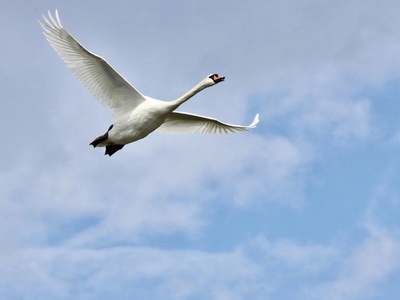
Mute Swan
A large, familiar white swan with an orange bill and black knob. Graceful on water but can be aggressive. Despite its name, it’s not mute, making various hissing and grunting sounds. It’s one of the world’s heaviest flying birds.
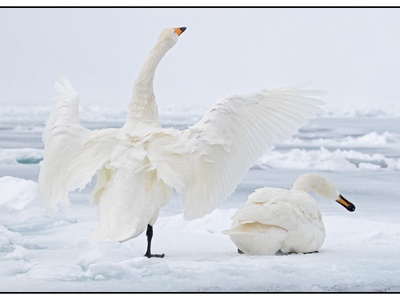
Whooper Swan
A large white swan with a long, straight neck and a wedge-shaped yellow and black bill. Named for its loud, bugle-like ‘whoop-whoop’ call, they migrate from Iceland to spend the winter in the UK, often in large, noisy flocks.
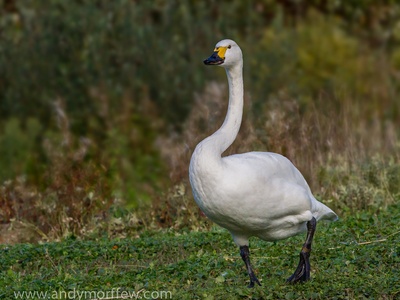
Bewick’s Swan
Our smallest swan, with a more rounded yellow patch on its black bill than the Whooper Swan. They undertake a perilous 2,500-mile migration from Arctic Russia each winter. The unique bill pattern of each individual can be used for identification.

Greylag Goose
A large, bulky grey goose with a stout orange bill and pink legs. This is the ancestor of most domestic geese. Its honking call is a familiar sound; native populations were once restricted but have expanded greatly in recent decades.
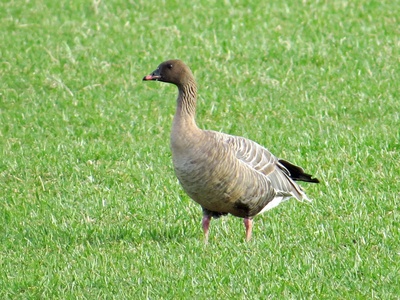
Pink-footed Goose
A medium-sized, brownish-grey goose with a short neck, dark head, and small pink-and-black bill. They arrive in autumn in huge, noisy skeins from their breeding grounds in Iceland and Greenland, feeding on leftover crops and grass.
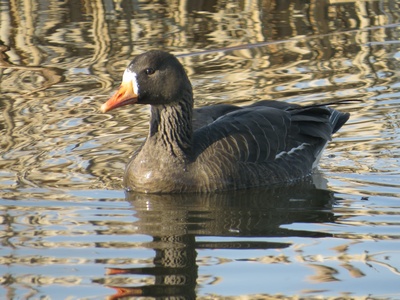
Greater White-fronted Goose
A grey-brown goose, recognised by the white patch at the base of its pinkish-orange bill and bold black bars on its belly. The birds that winter in the UK come from two different populations: Greenland and Siberia.
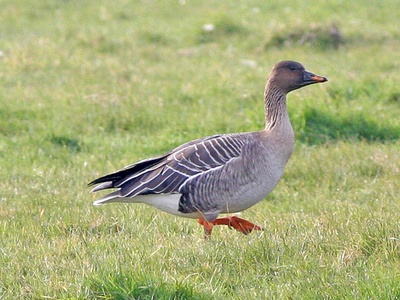
Bean Goose
A scarce winter visitor, this large, dark goose has orange legs and an orange patch on its dark bill. It is notoriously shy and difficult to approach. The UK holds internationally important populations at just a couple of specific sites.
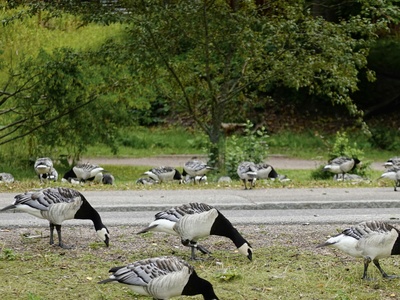
Barnacle Goose
A striking, medium-sized goose with a black neck, white face, and barred grey body. Arrives in huge, noisy flocks from Greenland and Svalbard. An old myth claimed they hatched from barnacles, hence the name. A small feral breeding population also exists.
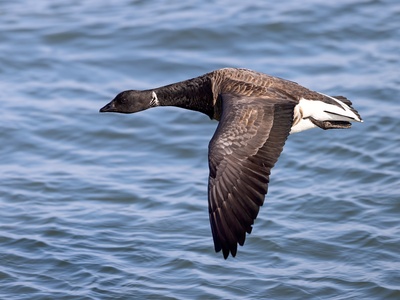
Brent Goose
A small, dark goose, similar in size to a Mallard, with a black head and neck and a small white neck patch. Feeds almost exclusively on eelgrass and algae in coastal estuaries. Three different races visit the UK from the high Arctic.
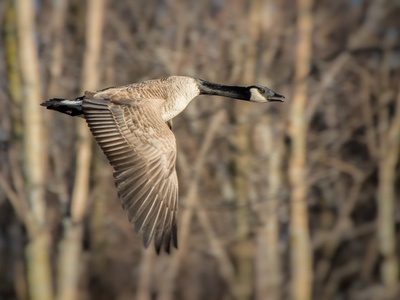
Canada Goose
A very large, familiar goose with a long black neck and head, distinctive white cheek patch, and brownish body. Introduced from North America, it is now a very common and often noisy resident, sometimes considered a pest due to its numbers.

Egyptian Goose
A distinctive pale brown and grey goose-like duck with a dark brown eye-patch and white wing patches visible in flight. Originally from Africa, it escaped from ornamental collections and is now well-established, known for its loud, rasping calls.
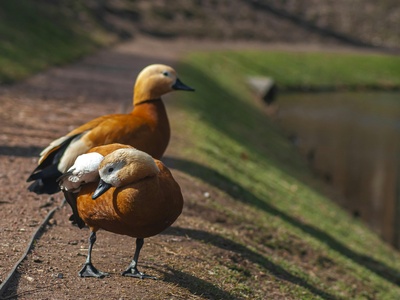
Shelduck
A large, colourful goose-like duck with a dark green head, white body, chestnut band, and a bright red bill. Often nests in old rabbit burrows. In late summer, almost the entire North-West European population moults in the Wadden Sea.

Mandarin Duck
An ornate and unmistakable duck, the male having an elaborate crest, orange ‘sails’ on its back, and intricate patterns. Originally from East Asia, it escaped from collections and now breeds ferally, nesting in tree holes near water.
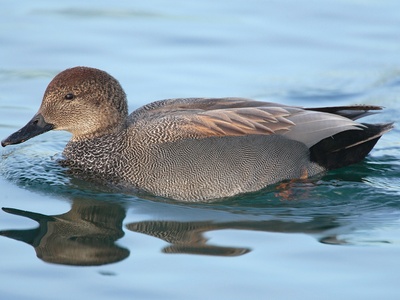
Gadwall
A subtly handsome, medium-sized duck. The male is finely patterned grey with a black rear end and a white patch on the wing, visible in flight. Less common than the Mallard, its population has increased significantly in the UK in recent years.
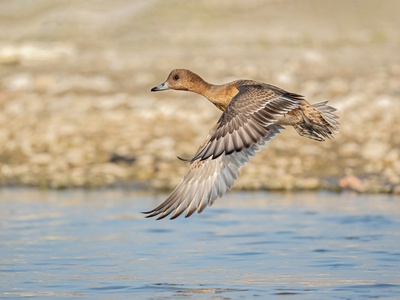
Wigeon
The male is a handsome duck with a grey body, pinkish breast, and a chestnut head with a creamy-yellow forehead. Its whistling ‘whee-ooo’ call is a classic winter sound across UK wetlands as huge flocks gather to graze on coastal marshes.

Mallard
The UK’s most common and familiar duck. The male has a glossy green head, yellow bill, and curly black tail feathers, while the female is mottled brown. It is the ancestor of nearly all domestic duck breeds except the Muscovy Duck.
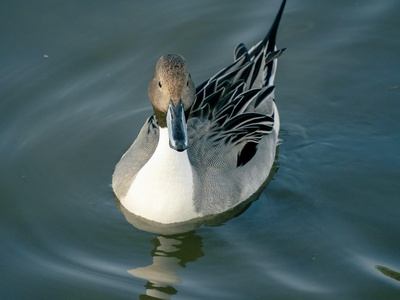
Pintail
An elegant, slender duck with a long neck. The male is striking with a chocolate-brown head, white neck-stripe, and a long, pointed black tail. A graceful swimmer, its UK population swells with thousands of wintering birds from Iceland and Siberia.

Garganey
A small, secretive duck, slightly larger than a Teal. The breeding male is distinctive with a broad white stripe over his eye. A summer visitor, it is one of the first migrant birds to leave for its African wintering grounds, often by August.

Shoveler
Instantly recognisable by its huge, spatula-shaped bill, which it uses to filter tiny invertebrates from the water. The male is colourful with a dark green head, white breast, and chestnut flanks. A surprisingly agile and fast flier.

Teal
The UK’s smallest duck. The male is subtly beautiful with a grey body and a chestnut head with a broad, metallic green eye-patch. A fast and agile flier, often seen in large flocks that twist and turn in unison.
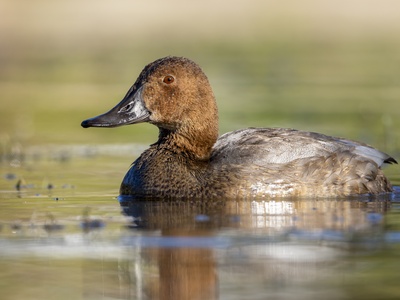
Pochard
A medium-sized diving duck. The male has a rusty-red head, black breast, and a pale grey body. Numbers have declined sharply, placing it on the UK’s Red List of conservation concern. They can dive up to 10 metres to find food.

Tufted Duck
A small, compact diving duck. The male is black and white with a distinctive tuft on the back of his head and a piercing yellow eye. The female is chocolate brown. It is the UK’s most common diving duck, first breeding here in 1849.

Scaup
A diving duck similar to the Tufted Duck, but the male has a grey back rather than black. It breeds in the Arctic and visits the UK in winter, forming large flocks (rafts) on the sea in favoured coastal areas like the Firth of Forth.
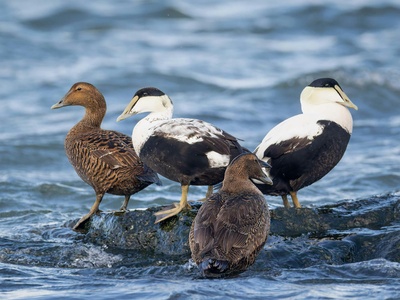
Eider
A large, heavy sea duck. The male is striking in black and white with a pale green nape and a distinctive wedge-shaped bill. Famous for its incredibly insulating down feathers, which the female uses to line her nest.

Long-tailed Duck
A small, elegant sea duck. The winter male is mostly white with dark markings and two very long central tail feathers. A deep diver, it can reach depths of 60 metres. Its yodelling call is a characteristic sound of Arctic coastlines.

Common Scoter
A medium-sized, all-black sea duck, the male having a small yellow patch on his bill. Often seen in large, dense flocks or ‘rafts’ far out at sea. A small, vulnerable population breeds on remote lochs in the Scottish Highlands.
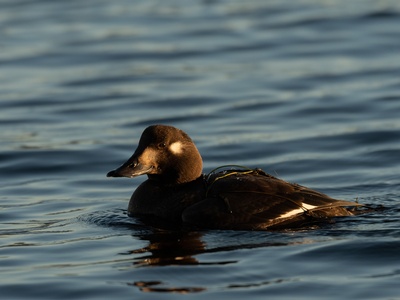
Velvet Scoter
A large, bulky black sea duck, distinguished from the Common Scoter by a small white patch under the eye and a large white panel on the wing, very obvious in flight. A scarce winter visitor from Scandinavia and Siberia.
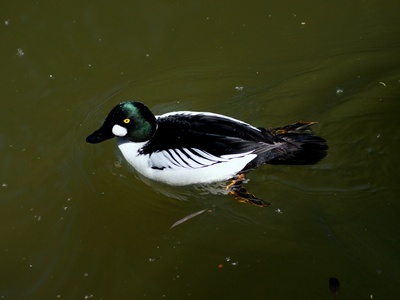
Goldeneye
A medium-sized diving duck. The male is strikingly black and white with a glossy green-black, triangular head and a round white spot by his bill. The name comes from its bright golden-yellow eye. Its wings make a whistling sound in flight.
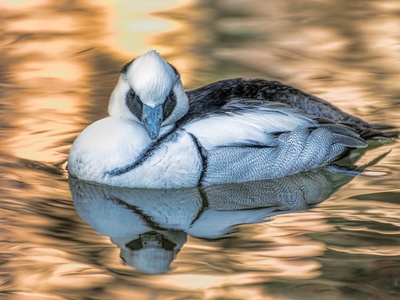
Smew
A small, sawbill duck. The male is a stunning ‘ice-duck’, mostly white with fine black lines and a black mask. The female, called a ‘redhead’, is grey with a chestnut cap. A scarce but sought-after winter visitor from northern Russia.

Goosander
A large, long-bodied diving duck with a saw-like bill for catching fish. The male is white and black with a dark green head, while the female is grey with a shaggy, rusty-brown head. They nest in tree holes, sometimes high above the ground.
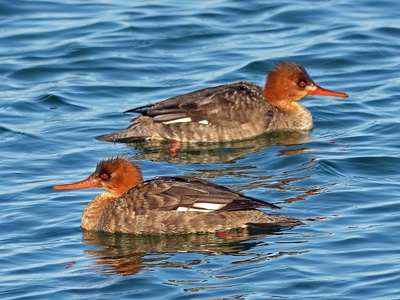
Red-breasted Merganser
A streamlined diving duck, slightly smaller than a Goosander. The male has a shaggy green-black head, white neck collar, and streaky brown breast. The female is grey-brown with a punk-rock hairstyle. Mostly found on saltwater in winter.

Ruddy Duck
A small, stiff-tailed duck. Breeding males are chestnut-brown with a black cap, white cheeks, and a bright blue bill. An introduced species from North America, it is now subject to a near-complete eradication programme to protect Europe’s native White-headed Duck.

Red-legged Partridge
A plump gamebird with a boldly striped flank, white throat bordered with black, and bright red legs and bill. Introduced from Europe for sport, it is now a common sight in the countryside, often seen running quickly along field edges.

Grey Partridge
A small, round gamebird, subtly coloured in grey, brown and orange, with a dark chestnut horseshoe mark on the male’s belly. Known for its explosive flight when disturbed. A native species that has suffered huge declines due to habitat loss.

Quail
A tiny, secretive, and dumpy gamebird, very difficult to see but with a distinctive, far-carrying ‘wet-my-lips’ call. It’s our only migratory gamebird, flying all the way from Africa to breed in UK crop fields during the summer.

Pheasant
The male is a large, ornate gamebird with iridescent copper plumage, a green head, and red wattles. Introduced from Asia for sport, it is now one of the UK’s most familiar countryside birds. Around 40 million are released annually.
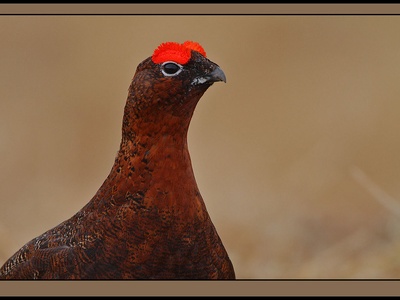
Red Grouse
A medium-sized, reddish-brown gamebird with feathered legs. It’s a unique UK subspecies of the Willow Ptarmigan, found nowhere else in the world. Famous for its gobbling ‘go-back, go-back’ call as it rockets over the heather.
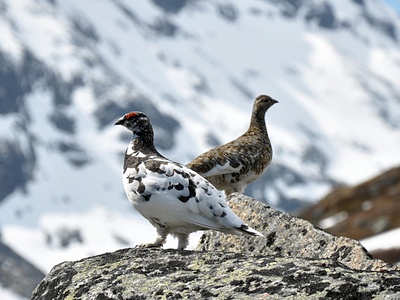
Ptarmigan
A hardy grouse adapted to Arctic-alpine environments. It has three seasonal plumages, moulting to pure white in winter to camouflage against snow. It is Britain’s only bird to turn fully white in winter. Found only on the highest Scottish peaks.
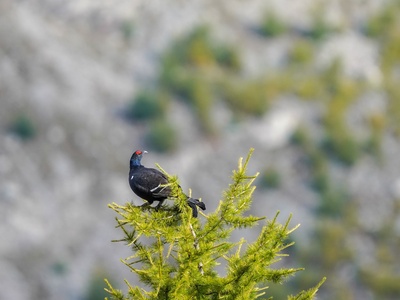
Black Grouse
A large grouse. The male is a striking all-black bird with a lyre-shaped tail and red wattles over the eye. Famed for its ‘lekking’ displays, where males gather at dawn to bubble, hiss, and posture to attract females. A rapidly declining species.
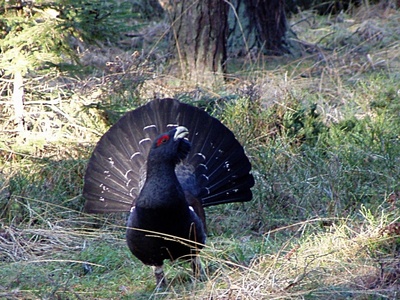
Capercaillie
The world’s largest grouse, the male being a huge, turkey-sized bird with dark, glossy plumage. Reintroduced to Scotland after becoming extinct. Its name means ‘horse of the woods’. Now critically endangered in the UK due to habitat loss.
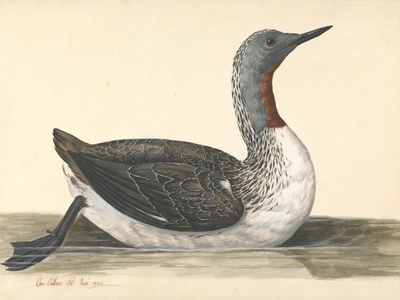
Red-throated Diver
The smallest of the UK’s divers, with a slender build and a distinctly upturned bill. In summer, it has a grey head and a neat red throat patch. Breeds on small lochans in the Scottish Highlands and Islands.

Black-throated Diver
An elegant, medium-sized diver. In breeding plumage, it is stunning with a grey head, black throat, striped neck, and chequered back. A rare breeding bird of large, fish-filled lochs in northern Scotland.
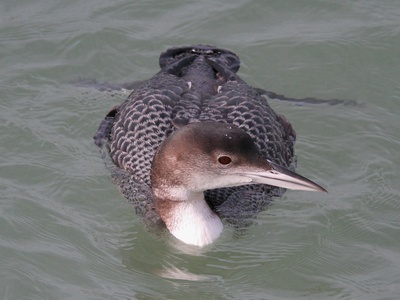
Great Northern Diver
A large, powerful diver with a heavy, dagger-like bill. In winter, it is dark above and white below. Its haunting, wailing calls, heard on its North American breeding grounds, have given it the name ‘Loon’. A key winter bird for coastal reserves.
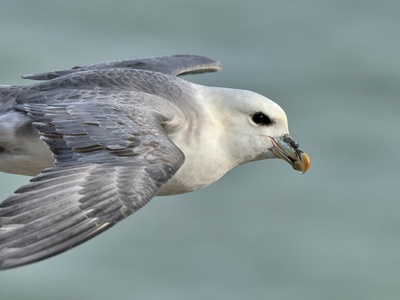
Fulmar
A gull-like seabird with stiff-winged, gliding flight. Related to albatrosses, they have a prominent tube on top of their bill. They defend their nests by spitting a foul-smelling, oily substance at intruders.
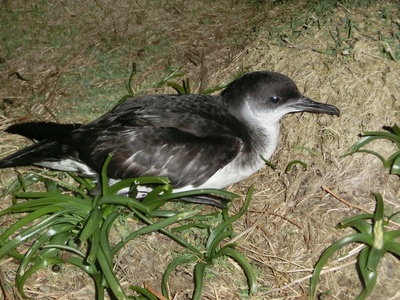
Manx Shearwater
A medium-sized seabird, black above and white below. It flies with a characteristic shearing action, banking low over the waves. They nest in burrows and are famous for their eerie, cackling calls at their colonies after dark.

Storm Petrel
A tiny, all-black seabird, no bigger than a starling, with a distinctive white rump. It flutters and patters its feet on the sea’s surface to feed. The smallest of all UK seabirds, it comes to its nesting burrows only under cover of darkness.

Leach’s Petrel
Slightly larger than the Storm Petrel, with a forked tail, a paler wing-bar, and a more bounding flight. A very rare breeding bird in the UK, found only on the most remote, predator-free Atlantic islands.
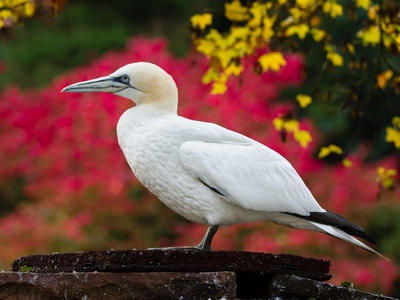
Gannet
A large, spectacular white seabird with black wingtips, a yellow-tinged head, and a powerful pointed bill. They are famed for their high-speed plunge dives, hitting the water like an arrow to catch fish. The UK hosts over half the world’s population.
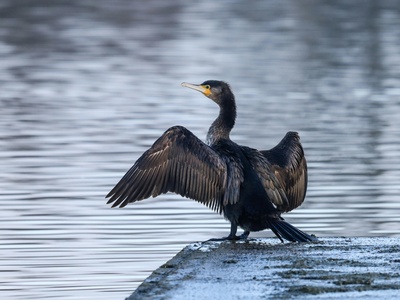
Cormorant
A large, dark, primitive-looking water bird, often seen holding its wings out to dry. It is an expert diver, pursuing fish underwater. During the breeding season, it develops a white patch on its thigh and a crest.
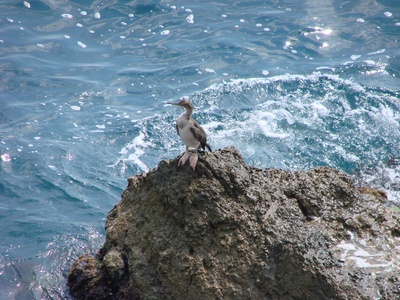
Shag
Similar to a Cormorant but smaller, more slender, and with a thinner bill. In breeding season, adults are glossy green-black and have a distinct crest. It is almost exclusively a coastal bird, rarely seen inland.

Bittern
A secretive, stocky heron, perfectly camouflaged in golden-brown and black streaks to blend into reedbeds. It is famous for its far-carrying ‘booming’ call in spring, which sounds like someone blowing over the top of a giant bottle.
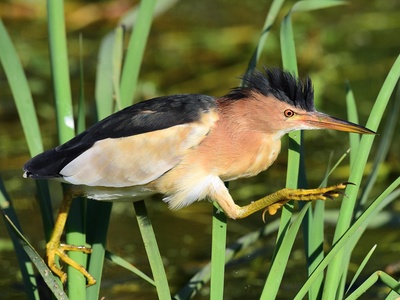
Little Bittern
A very small, extremely secretive heron. The male is black and buff, the female browner. A very rare visitor from Europe, it has bred in the UK on a handful of occasions but is a prize find for any birdwatcher.

Night-Heron
A stocky, medium-sized heron with a thick neck and short legs. Adults are smart with a black cap and back, grey wings, and white underparts. As their name suggests, they are most active at dusk and during the night. A rare visitor.
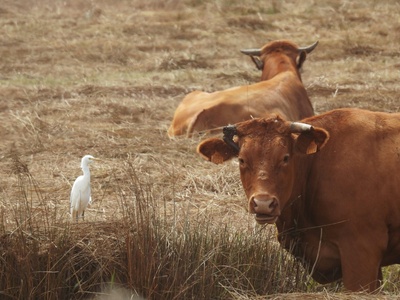
Cattle Egret
A small, stocky white egret. In breeding season, it develops buff plumes on its head, chest, and back. As its name suggests, it often associates with cattle, feeding on insects they disturb. A recent colonist, now breeding regularly.
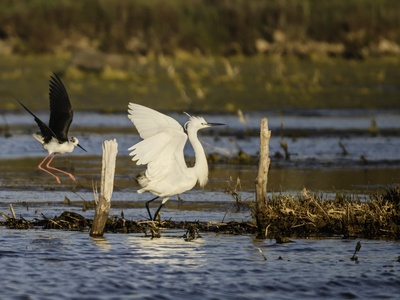
Little Egret
An elegant, small white heron with black legs and striking yellow feet. Once a rare vagrant, it first bred in the UK in 1996 and has since undergone a remarkable colonisation, becoming a common sight in southern Britain.
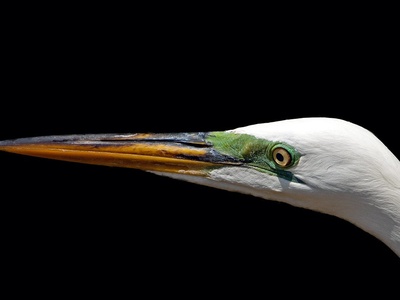
Great White Egret
A large, graceful white heron, as big as a Grey Heron but more slender. It has a dagger-like yellow bill (black in breeding season) and dark legs. Another recent colonist, its population is growing, and it is now a resident breeder.
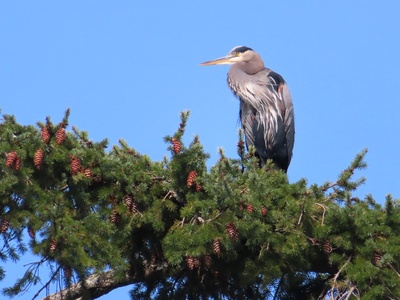
Grey Heron
A tall, stately bird with long legs, a snake-like neck, and a powerful dagger-like bill. It is a patient hunter, standing motionless in the shallows before striking at fish. Nests colonially in treetops in ‘heronries’.
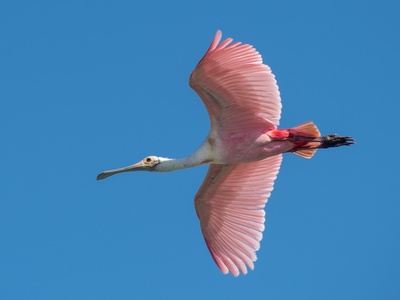
Spoonbill
A tall, white heron-like bird, instantly recognisable by its long, spatulate bill which it sweeps from side to side through the water to catch small invertebrates and fish. A rare but increasing breeding bird in the UK.

Glossy Ibis
A medium-sized waterbird with a long, downcurved bill. At a distance it looks black, but in good light, its plumage shows beautiful bronze, purple, and green iridescence. A rare but increasingly regular visitor from southern Europe.

Honey-buzzard
A medium-sized raptor, similar to a Common Buzzard but with a longer tail and a small, pigeon-like head. A secretive summer visitor that specialises in feeding on the grubs of wasps and bees, excavating their nests from the ground.
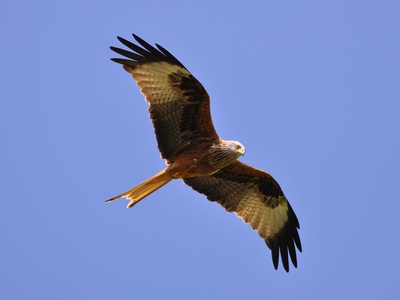
Red Kite
A large, graceful bird of prey with a reddish-brown body, angled wings, and a deeply forked tail. Once persecuted to near-extinction, it is one of the UK’s greatest conservation success stories following a major reintroduction programme.

White-tailed Eagle
A huge, majestic bird of prey with a massive wingspan (up to 2.5m), a large pale head, and a wedge-shaped white tail in adults. Nicknamed the ‘flying barn door’, it was successfully reintroduced to Scotland and more recently to England.

Hen Harrier
A slender raptor famed for its low, quartering flight over moorland. The male is a ghostly pale grey (‘the grey ghost’), while the female is brown with a barred tail and a prominent white rump. Heavily persecuted on driven grouse moors.
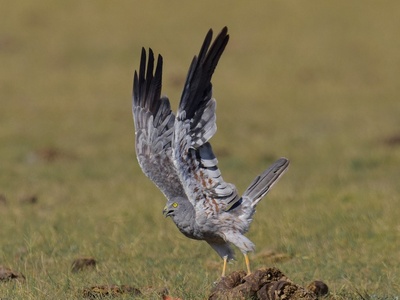
Montagu’s Harrier
The UK’s rarest breeding bird of prey. It is more slender and elegant than the Hen Harrier. The male is pale grey with a black wingbar. A summer visitor from Africa, its nest sites are kept secret to protect them from disturbance.

Sparrowhawk
A small bird of prey with broad wings and a long tail, adapted for agile flight through woodland. The male is small and blue-grey, the female larger and browner. A formidable hunter of small birds, now a common sight in gardens.
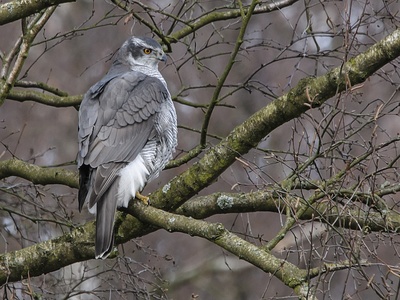
Goshawk
A large, powerful version of a Sparrowhawk, often called the ‘phantom of the forest’ due to its secretive nature. A fierce hunter capable of taking prey up to the size of a pheasant. Persecuted in the past, it is slowly recovering its numbers.

Common Buzzard
The UK’s most common and widespread bird of prey. A medium-sized raptor, often seen soaring high in the sky on broad wings, with a fan-shaped tail. Its cat-like ‘mewing’ call is a very familiar countryside sound.

Golden Eagle
A huge, majestic bird of prey with long, broad wings and a dark brown body. Famed for its soaring flight over mountains and moorland. It is an icon of the Scottish wilderness, preying on mountain hares and grouse.
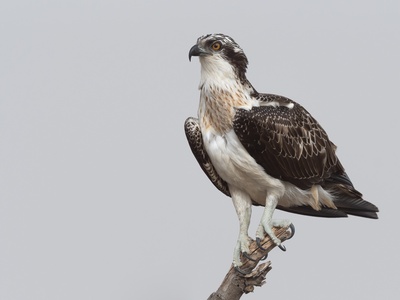
Osprey
A large, fish-eating bird of prey with long, angled wings. It is dark above and white below, with a distinctive white head and dark eye-stripe. A spectacular sight as it plunges feet-first into water to catch fish. A migrant, wintering in West Africa.
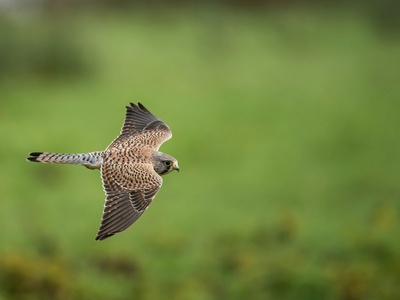
Kestrel
A small falcon, famous for its ability to hover motionless in the wind while it scans the ground for small mammal prey. The male has a grey head and tail, while the female is a more uniform rufous-brown. Has adapted well to motorway verges.

Merlin
The UK’s smallest bird of prey. A small, dashing falcon built for speed, it hunts small birds like Meadow Pipits in a high-speed chase. The male is slate-blue above, the female is darker brown. Moves to lowlands and coasts for winter.
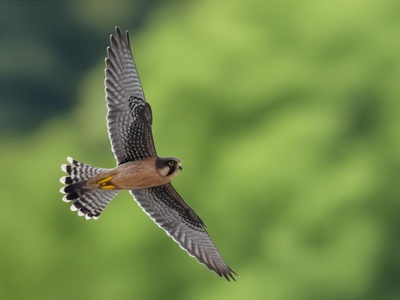
Hobby
A small, sleek, and acrobatic falcon, like a giant swift. It is a summer visitor, famed for its incredible aerial skills, catching dragonflies and even swallows and martins on the wing. It winters in sub-Saharan Africa.
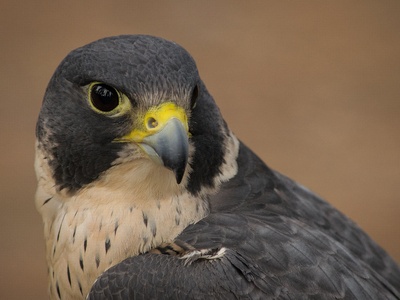
Peregrine Falcon
The fastest animal on the planet, reaching speeds of over 200 mph in its hunting dive (stoop). A powerful, stocky falcon that preys on medium-sized birds. Has adapted well to city life, nesting on cathedrals and power stations.

Water Rail
A shy, elusive bird of dense wetland vegetation. It has a long red bill, olive-brown back, and grey face and underparts. It is heard far more often than seen, its bizarre ‘sharming’ call sounding like a squealing piglet.
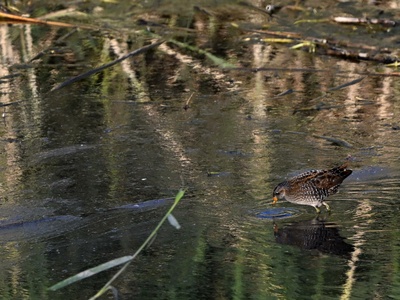
Spotted Crake
A small, secretive rail, smaller than a Water Rail, with a short, yellowish bill. It is olive-brown with white spots and flecks. A very rare and elusive summer visitor, its presence is usually only given away by its repetitive, whip-lash call at night.

Corncrake
A secretive, land-dwelling rail, famous for its loud, rasping ‘crex-crex’ call, which gives it its name. Once widespread, it suffered catastrophic declines. Now confined to a few areas where traditional, wildlife-friendly farming is practiced.
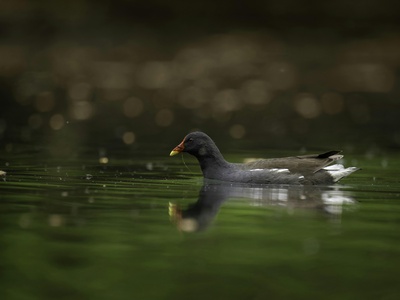
Moorhen
A common and familiar water bird, dark in colour with a white line along its flank and a white patch under the tail. It has a distinctive red bill with a yellow tip. Often seen jerking its head as it swims or flicking its tail as it walks.
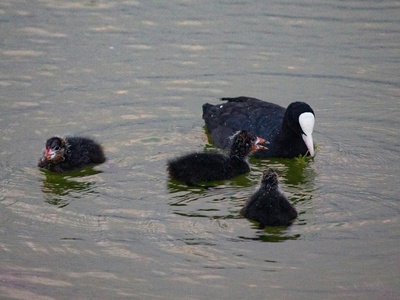
Coot
A plump, black water bird with a distinctive white bill and ‘shield’ on its forehead. Larger than a Moorhen and often more aggressive, it is known for its noisy squabbles. It has lobed, not webbed, feet, which help it propel through the water.
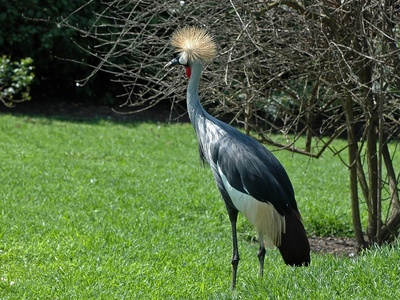
Crane
A huge, majestic grey bird with long legs, a long neck, and a drooping ‘bustle’ of tail feathers. Its loud, bugling call is unforgettable. Once extinct in the UK, it has made a successful return through reintroduction and natural recolonisation.

Oystercatcher
A large, noisy black-and-white wading bird with a long, bright orange-red bill and pink legs. Despite its name, it rarely eats oysters, instead feeding mainly on cockles and mussels. Its loud, piping call is a classic sound of the coast.

Avocet
An elegant black and white wader with a unique, long, upcurved bill and long blue-grey legs. It feeds by sweeping its bill from side to side in shallow water. The emblem of the RSPB, its return to breed in the UK is a major conservation success.
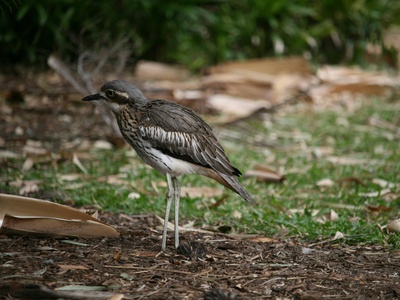
Stone-curlew
A strange, stocky wader with large, staring yellow eyes, long yellow legs, and cryptic, sandy-brown plumage. A nocturnal bird with a loud, wailing call, it is a rare and protected summer visitor to specific open, stony habitats.
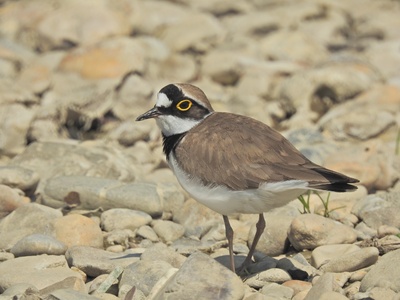
Little Ringed Plover
A small, delicate wader, similar to the Ringed Plover but with a plain black bill, a distinct yellow eye-ring, and no wing-bar in flight. A summer visitor that often nests on man-made habitats like recently worked gravel pits.

Ringed Plover
A small, dumpy wader with a black and white head pattern, a black breast-band, and an orange bill with a black tip. A familiar sight on sandy and shingle beaches, it lays its camouflaged eggs in a simple scrape on the ground.
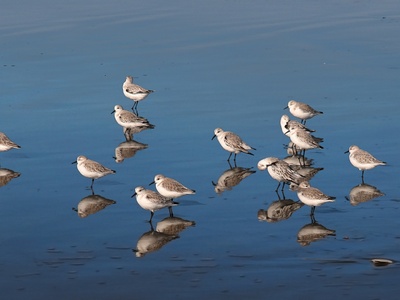
Kentish Plover
A very rare plover, similar to the Ringed Plover but paler, with an incomplete breast-band and dark legs. It used to breed in the UK but is now only a rare passage migrant, a sad symbol of coastal habitat loss.
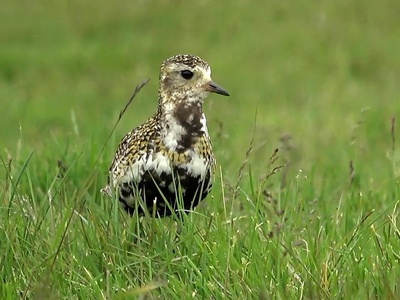
Golden Plover
A beautiful medium-sized wader, spangled with gold and black in summer. In winter, it is a duller grey-brown. Forms huge, swirling flocks in winter, their mournful, whistling calls a feature of open fields and estuaries.

Grey Plover
Slightly larger and stockier than the Golden Plover. In its stunning summer plumage, it is black below and spangled silvery-grey above. In winter, it’s a more uniform grey. A purely coastal bird in the UK, found on estuaries.
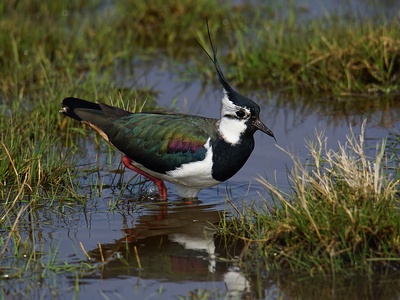
Lapwing
An unmistakable wader with broad, rounded wings, iridescent green-black plumage, a long wispy crest, and a shrill ‘pee-wit’ call, which gives it its other name. Famous for its spectacular, tumbling aerobatic display flight in spring.
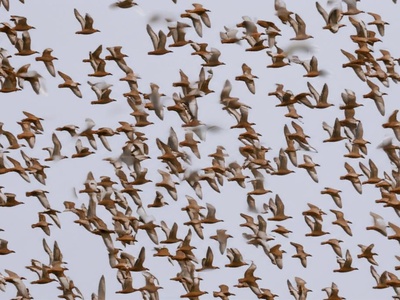
Knot
A medium-sized, stocky wader. In winter, it is plain grey, but in summer, it moults into a stunning brick-red plumage. Forms vast, tightly-packed flocks that perform incredible aerial manoeuvres, flashing from grey to white as they turn in unison.

Sanderling
A small, pale wader, almost white in winter. Famous for its clockwork-mouse feeding action, running back and forth along the shoreline, chasing the waves to pick up small invertebrates from the wet sand.
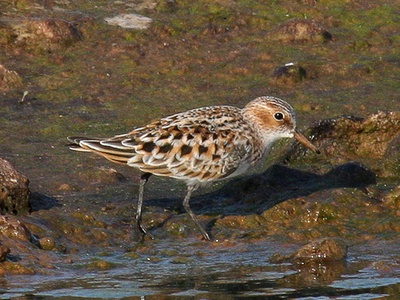
Little Stint
A tiny wader, only slightly larger than a sparrow. It has a fine-tipped bill and black legs. A passage migrant, seen mainly in autumn on its way from Arctic breeding grounds to Africa. Often found feeding alongside Dunlin.
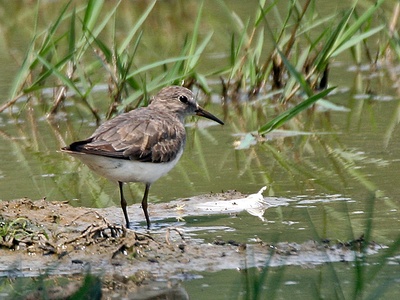
Temminck’s Stint
A very small wader, similar to Little Stint but with duller, grey-brown plumage and yellowish-green legs. Unlike most waders, it has a distinctive habit of suddenly rocketing vertically into the air when flushed. A scarce migrant.

Curlew Sandpiper
An elegant wader with a long, decurved bill. In breeding plumage, it has a beautiful deep chestnut-red belly. A passage migrant, seen in small numbers, particularly in autumn, often associating with flocks of Dunlin.

Dunlin
The UK’s most common small wader. A versatile bird, breeding on moorland and wintering in huge numbers on estuaries. In summer, it has a black belly patch; in winter, it is a plainer ‘little grey bird’. Comes in many different subspecies.

Ruff
A medium-sized wader. The male is famous for its spectacular breeding plumage, with a huge ruff and ear-tufts that come in an incredible variety of colours. Males display together at ‘leks’ to attract the plainer females (Reeves).
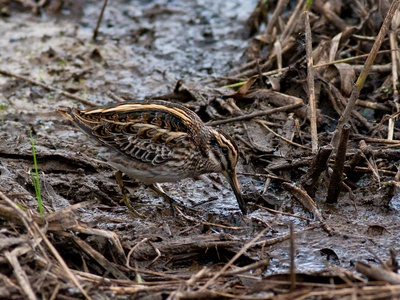
Jack Snipe
A small, secretive wader, smaller than the Common Snipe, with a shorter bill. It has a distinctive bobbing motion when feeding. When flushed, it flies low and for a short distance before dropping back into cover, unlike the zigzagging Snipe.
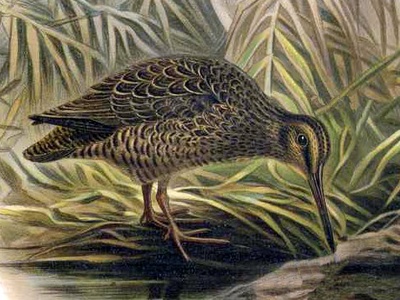
Snipe
A medium-sized wader with a very long, straight bill and cryptic brown plumage. Famous for its ‘drumming’ or ‘bleating’ display flight, where the vibrating outer tail feathers create a strange, ethereal sound.

Woodcock
A bulky, secretive wader with a long bill and beautifully camouflaged dead-leaf plumage. It is largely nocturnal, spending the day hidden on the woodland floor. Famous for its ‘roding’ display flight at dusk over the treetops.

Black-tailed Godwit
A large, elegant wader with very long legs and a long, straight bill. In summer, it has a bright orange-copper head and breast. The Icelandic-breeding birds that winter here are a different, larger and brighter subspecies.
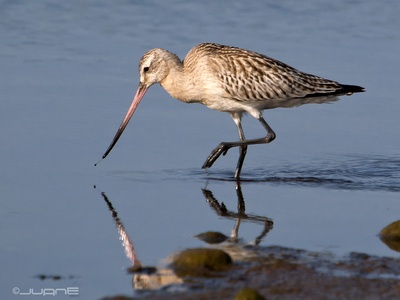
Bar-tailed Godwit
Slightly smaller than the Black-tailed Godwit, with shorter legs and a slightly upturned bill. In summer, the male is a deep brick-red. It holds the record for the longest non-stop migratory flight of any bird, over 7,000 miles.
